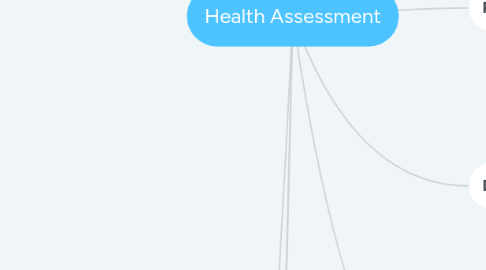
1. Environment Prep
1.1. provide a quiet and private room
1.2. prep exam table
1.3. provide grown/drapes for patient
1.4. gather instruments and special supplies
1.5. empty bladder before examination
2. Guidelines for Conducting health history
2.1. Biographical Data
2.1.1. sex
2.1.2. age
2.1.3. dob
2.1.4. marital stat
2.1.5. name
2.1.6. address
2.1.7. billing and insurance info
2.1.8. occupation
2.1.9. race
2.1.10. ethnic
2.1.11. religious pref.
2.1.12. primary healthcare provider
2.2. Reason for seeking health care
2.2.1. patient's own words
2.2.2. ask open-ended Questions
2.3. history of present health concern
2.3.1. explore symptoms thoroughly
2.3.2. encourage to describe and explain patient symps
2.3.3. on set problems? Location? duration? intensity? quality/description? relieving/exacerbating factors? associated factors? past occurrences? any treatments? how the problem affected patient?
2.4. past history
2.4.1. alerts certain risk factors
2.4.2. childhood and adult illness
2.4.3. chronic health problems and treatments
2.4.4. previous surgeries/hospitalization
2.4.5. accident/injuries
2.4.6. obstetric hist
2.4.7. allergies
2.4.8. date most recent immunization
2.5. fam history
2.5.1. certain disorders= genetic links
2.6. functional health assessment
2.6.1. effects of health or illness on patient's quality of life
2.6.1.1. Patient's strength and improvements
2.6.2. activities of daily living (ADL's) - self care activities
2.6.2.1. eating, bathing, dressing
2.6.3. instrumental activities of daily living (IADLs)- needed for independent living
2.6.3.1. housekeeping, meal prep, management of finances, transportation
2.7. psychosocial and lifestyle factors
2.7.1. end of interview
2.7.2. ask about patient's social support and network of available assistance
2.7.3. patient's level of activity
2.7.4. mental health stat
2.8. Review of systems
2.8.1. series of questions about body systems that help reveal probs
2.8.2. Can be done while doing physicals
3. Physical Assessment Techniques
3.1. Inspection
3.1.1. deliberate, purposeful observations,
3.1.2. observe visually but also hearing and smell to gather info
3.1.3. appearance, behavior, and movement
3.1.4. begins w/ initial patient contact
3.1.5. distinguish color, texture, moisture of body surfaces
3.1.6. size, color, shape, position, movement and symmetry
3.2. Palpation
3.2.1. sense of touch
3.2.2. skin temp, turgor, texture, moisture, vibrations, shape or structure
3.2.3. ask for permission to touch
3.3. Percussion
3.3.1. striking one object w/ another to produce sound
3.3.2. abnormal sound= alteration of tissues or presence of mass
3.3.3. tap of fingers over body tissues to produce vibrations and sound waves
3.4. Auscultation
3.4.1. listening w/ stethoscope to sounds produced within body
3.4.2. pitch, loudness, quality and duration
4. physical assessment in systematic manner
4.1. head to toe
4.2. sequence of exam
4.3. General survey
4.3.1. health hist
4.3.2. appearance and behavior
4.3.3. height and weight
4.3.4. vital signs
4.4. assessing integument
4.4.1. health hist
4.4.2. physical assessment
4.4.3. inspecting skin color
4.4.4. palpating skin temp, text, moisture, turgor
4.4.5. inspecting nails
4.4.6. inspecting hair and scalp
4.5. assessing head and neckj
4.5.1. health hist
4.5.2. physical assessment
4.5.3. inspecting eyes
4.5.4. assessing visual acuity, extraocular movements, peripheral visions
4.5.5. inspecting and palpating the ears
4.5.6. assessing and palpating external ear
4.5.7. assessing hearing and sound conduction
4.5.8. inspecting nose
4.5.9. palpating sinuses
4.5.10. inspecting mouth and pharynx
4.5.11. inspecting and palpating neck
4.5.12. inspecting and palpating trachea
4.5.13. inspecting thyroid gland
4.6. assessing thorax and lungs
4.6.1. health hist
4.6.2. physical assessment
4.6.3. inspecting thorax
4.6.4. palpating thorax
4.6.5. ausculating breath sounds
4.7. assessing Cardiovascular and peripheral vascular system
4.7.1. health hist
4.7.2. physical assessment
4.7.3. inspecting neck and precordium
4.7.4. palpating neck and precordium
4.7.5. auscultating carotid arteries
4.7.6. auscultating heart sounds
4.7.7. inspecting extremities
4.7.8. papating peripheral pulses and capillary refill
4.7.9. assessing neurovascular stat
4.8. assessing breats and axillae
4.8.1. health hist
4.8.2. physical assessment
4.8.3. inspecting breasts
4.8.4. palpating the breasts and axillae
4.9. assessing abdomen
4.9.1. health hist
4.9.2. physical assessment
4.9.3. inspecting abdomen
4.9.4. auscltating bowel sounds and vascular sounds
4.9.5. palpating abdomen
4.10. assessing female genitalia
4.10.1. health hist
4.10.2. physical assessment
4.10.3. inspecting and palpating external genatilia
4.10.4. inspecting internal genitalia
4.11. assessing male genitalia
4.11.1. health hist
4.11.2. inspecting and palpating external genitalia
4.11.3. inspecting and palpating inguinal area
4.12. Assessing rectum and anus
4.12.1. health hist
4.12.2. physical assessment
4.13. assessing musculoskeletal systemm
4.13.1. health hist
4.13.2. physical assessment
4.13.3. inspecting and palpating muscles
4.13.4. palpating bones
4.13.5. inspecting and palpating joints
4.13.6. inspecting spinal curves
4.14. assessing neurologic system
4.14.1. health hist
4.14.2. physical assessment
4.14.3. assessing mental stat
4.14.4. assessing level of consciousness
4.14.5. assessing level of awareness
4.14.6. assessing memory
4.14.7. assessing language
4.14.8. assessing cranial nerve functions
4.14.9. assessing motor and sensory function
4.14.10. inspecting balance and gait
4.14.11. assessing motor function and coordination
4.14.12. assessing sensory perception
4.14.13. neurovascular assessment
5. Describe nursing responsibilites
5.1. diagnostic procedure and lab tests become total health assessment
5.2. nurses assist before, during and after
5.3. witnessing patient consent
5.4. scheduling tests
5.5. preparing patient physically and emotionally for tests
5.6. providing care
5.7. teaching patient/care givers about ordered procedures/tests
6. Purposes
6.1. gathering info about about health status of the patient
6.2. evaluates and synthesize the information
6.3. plans appropriate nursing interventions based on data and evaluate outcomes
7. Types
7.1. physical
7.1.1. changes in the patient's body
7.2. comprehensive
7.2.1. broad
7.2.2. complete health history and physical assessment
7.3. ongoing partial
7.3.1. follow up
7.3.2. conducted @ regular intervals
7.3.3. concentrates on identified problems to monitor +/- changes
7.4. focused
7.4.1. specific problems
7.4.2. address the immediate and highest priority concern
7.5. emergency
7.5.1. rapid focused
7.5.2. life-threatening or unstable situations
